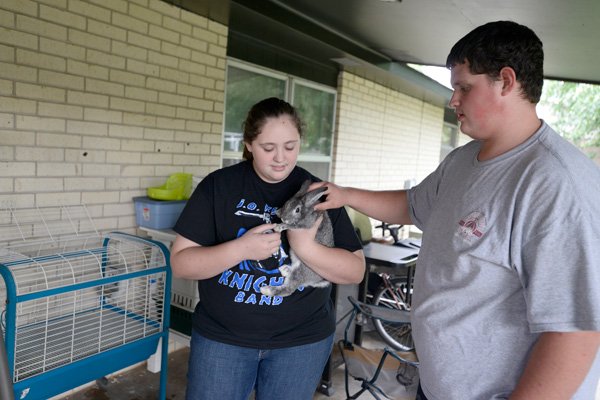SPRINGDALE — Garrett Day said he wouldn’t be able to work with heifers if it weren’t for his partnership with a local farmer.
Day, the 16-year-old vice president of Future Farmers of America at Springdale High School, said he wants to have the experience of raising cattle to prepare him for a career in food science. Day lives in an urban area near Sunset Avenue and 40th Street, where it’s impossible to raise livestock. The only animal at his house is his younger sister’s rabbit.
About 5 percent of the students in Future Farmers of America at Springdale High School live in a rural area, said Chad Burkett, chapter adviser. Living in an urban area can limit the type of animal a student can have at their home. Some students can’t have an animal at at all because of apartment rules, he said.
By The Numbers
Future Farmers Of America
215 — Students in Future Farmers of America at Springdale High School
75-80 — Students in Future Farmers of America at Springdale High School who have animals at home
125 — Students in Future Farmers of America at Har-Ber High School
50 — Students in Future Farmers of America at Har-Ber High School who have animals at home
70 — Students in Future Farmers of America at Fayetteville High School
10 or less — Students in Future Farmers of America at Fayetteville High School who have animals at home
40-50 — Students in Future Farmers of America at Rogers High School
3-4 – Students in Future Farmers of America at Rogers High School who have animals at home
40 — Students in Future Farmers of America at Heritage High School
12 — Students in Future Farmers of America at Heritage High School who have animals at home
60 — Students in Future Farmers of America at Bentonville High School
18 — Students in Future Farmers of America at Bentonville High School who have animals at home
Source: Staff Report
Students who can’t have an animal at home and want to work in agriculture miss out on gaining hands-on experience and skills, said Randy Davis, Future Farmers of America adviser at Heritage High School in Rogers. Students can also learn about animals through agriculture classes, but it doesn’t allow them to have the same pride in their work that they gain from raising and taking care of an animal.
“You can’t read a book and do it,” he said.
Livestock, such as chickens, goats, horses, cattle and pigs, can’t be kept within city limits of Springdale or Bentonville unless the area is zoned for agriculture, according to city officials. Poultry can be kept within city limits in Rogers, according to city ordinances. Fayetteville residents can have up to four chickens, but cannot have any other type of livestock animal within city limits, said Joni Mosher, office manager at the Fayetteville Animal Shelter.
Burkett and Patti Priest, Future Farmers of America adviser at Har-Ber High School in Springdale, said they’ve found ways for their students to work with animals even if they can’t have them at home.
Most students who live in apartments and want to have an animal have rabbits because they are small and don’t require a lot of space, Priest said. Students with rabbits learn the same grooming, training and nutrition skills they would with other animals.
One of her students lives in an apartment but wanted to have a sheep, Priest said. She helped the student set up a pen at the school where the student can take care of the animal. The sheep is allowed on campus because it is a temporary educational project and she has permission from district administrators.
Priest said she would also like to have facilities for cattle on campus. She is working on grants to get money for more pens and a covered area for animals.
Burkett said he makes a point of connecting with farmers and community members in Springdale to help his students. When a student can’t have an animal at their home, it’s sometimes possible to have them work with a farmer who will let them help with animals.
“If a kid wants to do it, we’ll find out a way to make it happen,” he said.
Day said he goes to a farm in Springdale every day after school to take care of a couple of heifers. The experience has taught him to take responsibility for his work.
“I have something that I can call mine,” he said.
Not being able to have an animal at home only impacts a small group of agriculture students, because many are becoming more interested in the science and mechanics side of the industry, said James Cannon, vice president of Region 2 for the National Association of Agricultural Educators. Region 2 includes Arkansas, Kansas, Louisiana, Oklahoma, Texas, Colorado and New Mexico.
Many students are focusing on food science, poultry science and areas of agriculture rather than animal production, because there has been a shift in the industry, Cannon said. The number of farmers working in production has decreased over the last 100 years because of technology use in the industry, said Bob Clay, Future Farmers of America adviser at Rogers High School.
Regardless of technology, a basic understanding of food production and animals is still essential to the industry, Davis said. Professionals in the agriculture field need to understand how animals are raised even if they don’t work in production themselves.
“All the technology is great and good, but without the basics, we don’t have anything,” he said.

